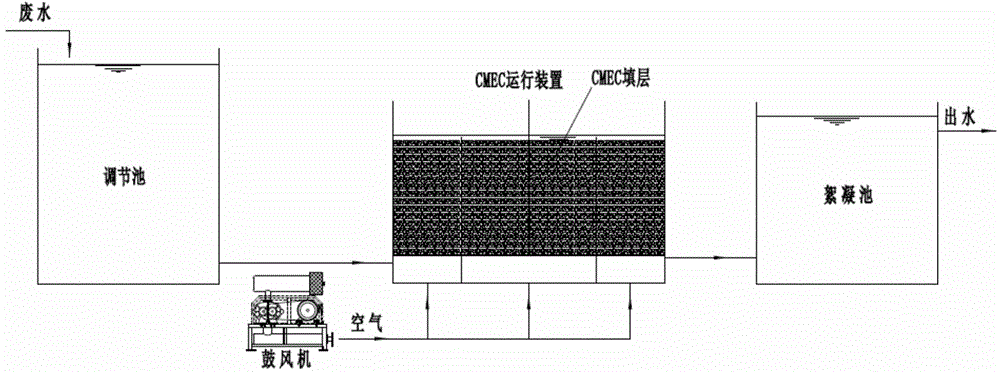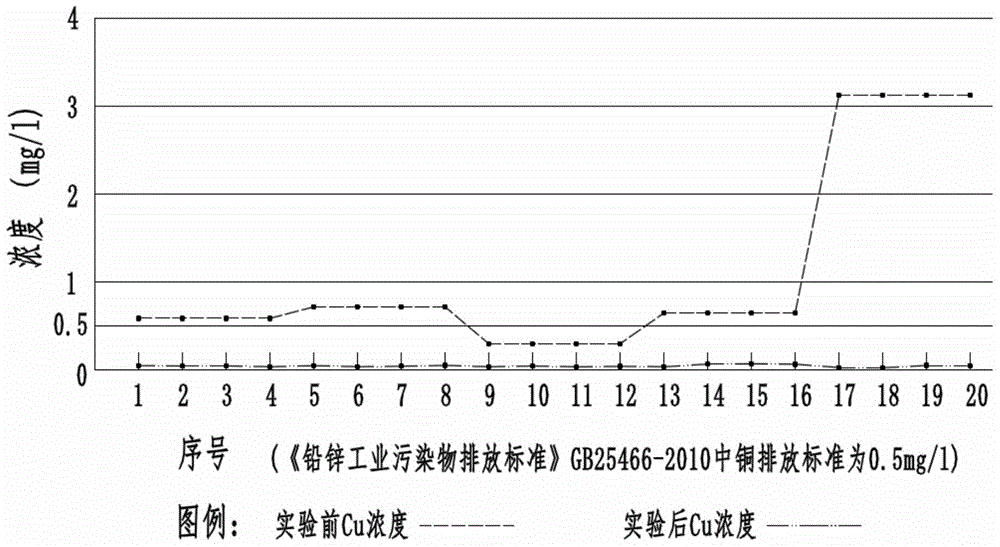Catalytic micro-electrolysis material and preparation method thereof
A micro-electrolysis and catalyst technology, which is applied in chemical instruments and methods, physical/chemical process catalysts, chemical/physical processes, etc., can solve the problems of reduced effective contact area between filler and wastewater, reduced treatment effect, and easy agglomeration. Achieve the effect of easy industrial production, increase specific surface area, and increase strength
- Summary
- Abstract
- Description
- Claims
- Application Information
AI Technical Summary
Problems solved by technology
Method used
Image
Examples
Embodiment 1
[0047] see figure 1 As shown in the process flow diagram, iron powder with a particle size of less than 40 mesh, graphite powder with a particle size of less than 80 mesh, manganese dioxide with a particle size of less than 100 mesh, and catalyst CuCl with a particle size of less than 120 mesh 2 Be raw material, measure by weight percentage as follows: Iron powder: Graphite powder: Manganese dioxide: CuCl 2 =65%: 25%: 9.01%: 0.09%, put into the mixer and mix evenly, enter the granulator to granulate into Φ3~8mm or Φ8~20mm spherical particles. After drying, put it into a high-temperature furnace to isolate the air and heat it at 900°C-1200°C for 100-120min. After the material is roasted, it is cooled naturally to obtain CMEC.
[0048] The CMEC prepared by the above-mentioned examples is used to treat wastewater from a smelter, and its treatment process is as follows: figure 2 shown. The processing effect is as follows:
[0049]
[0050]
[0051] The comparison of Cu ...
Embodiment 2
[0053] Iron powder with a particle size of less than 40 mesh, graphite powder with a particle size of less than 80 mesh, manganese dioxide with a particle size of less than 100 mesh, and catalyst CuCl with a particle size of less than 120 mesh 2Be raw material, measure by weight percentage as follows: Iron powder: Graphite powder: Manganese dioxide: CuCl 2 =75%: 15%: 9.95%: 0.05%, put into the mixer and mix evenly, enter the granulator to granulate into Φ3~8mm or Φ8~20mm spherical particles. After drying, put it into a high-temperature furnace to isolate the air and heat it at 900°C-1200°C for 100-120min. After the material is roasted, it is cooled naturally to obtain CMEC.
[0054] The effect of using the CMEC prepared in Example 2 and the process to the wastewater treatment of a certain pigment factory is as follows:
[0055]
[0056] Comparison of COD concentration fluctuations before and after wastewater treatment in the above table Figure 7 shown.
Embodiment 3
[0058] Iron powder with a particle size of less than 40 mesh, graphite powder with a particle size of less than 80 mesh, manganese dioxide with a particle size of less than 100 mesh, and catalyst CuCl with a particle size of less than 120 mesh 2 Be raw material, measure by weight percentage as follows: Iron powder: Graphite powder: Manganese dioxide: CuCl 2 =85%: 7%: 7.99%: 0.01%, put into the mixer and mix evenly, enter the granulator to granulate into Φ3~8mm or Φ8~20mm spherical particles. After drying, put it into a high-temperature furnace to isolate the air and heat it at 900°C-1200°C for 100-120min. After the material is roasted, it is cooled naturally to obtain CMEC.
[0059] The effect of using the CMEC prepared in Example 3 and the process to treat As in the wastewater of a certain electroplating factory is as follows:
[0060] Detection data of heavy metal As in raw water and effluent water
[0061]
[0062] The concentration fluctuation comparison of As in the ...
PUM
| Property | Measurement | Unit |
|---|---|---|
| Particle size | aaaaa | aaaaa |
| Particle size | aaaaa | aaaaa |
| Particle size | aaaaa | aaaaa |
Abstract
Description
Claims
Application Information
 Login to View More
Login to View More - R&D
- Intellectual Property
- Life Sciences
- Materials
- Tech Scout
- Unparalleled Data Quality
- Higher Quality Content
- 60% Fewer Hallucinations
Browse by: Latest US Patents, China's latest patents, Technical Efficacy Thesaurus, Application Domain, Technology Topic, Popular Technical Reports.
© 2025 PatSnap. All rights reserved.Legal|Privacy policy|Modern Slavery Act Transparency Statement|Sitemap|About US| Contact US: help@patsnap.com



